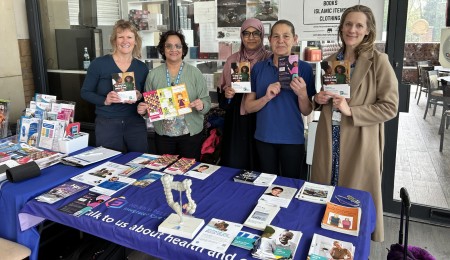Background
Early detection of cancer significantly improves treatment outcomes and survival rates. It's also one of the key priorities in the NHS Core20PLUS5 approach to reducing health inequalities. A national target is in place to diagnose 75% of cancers at Stage 1 or 2 by 2028.
While clinical action plays a vital role, community engagement is equally essential. In Hounslow, the Public Health team recognised that raising awareness about cancer symptoms and screening within local communities could directly support earlier detection and better health outcomes.
Taking Action Locally
In 2022, the Health Improvement Team created a dedicated role to drive cancer awareness and screening engagement. This enabled a stronger focus on community-based conversations and targeted outreach. Since then, cancer messaging has become embedded across the team’s activities—from one-to-one engagements to campaigns and events delivered in partnership with the NHS and community organisations.

All Health Outreach Team (HOT) members have been trained on cancer symptoms and screening, equipping them to have meaningful conversations with residents and refer them to further support.
Aims of the Programme
The core aim was to increase awareness and uptake of the three national cancer screening programmes, as well as the new lung cancer screening (formerly Lung Health Checks) initiative:
- Cervical screening (ages 25–64): National target 80%
- Breast screening (ages 50–71): National target 70%
- Bowel screening (ages 50–74): National target 60%
- Lung cancer screening (ages 55–74, current/former smokers): Piloted in Hounslow from May 2024
Initial local uptake rates (2021) were below national targets, particularly among certain groups, including people with learning disabilities, serious mental illness, new entrants into screening programmes, and some ethnic minority communities.
Collaborative Approach
A borough-wide Cancer Working Group was re-established post-COVID, bringing together NHS partners, the NWL Cancer Alliance, screening services, and local authority teams. A detailed project plan was created, identifying priority groups and partnership opportunities.
The Health Improvement Team led on a range of creative, targeted activities:
- Beauty salons helped co-design cervical screening materials and hosted information campaigns.
- Faith groups and community venues became key outreach sites.
- Learning disability-specific events tailored messaging and support.
- Healthy workforce visits included cancer awareness conversations with local staff.
- Social prescribers, community connectors, and stop smoking advisors were all trained to promote relevant screening programmes.
- Street signage and estate noticeboards carried awareness messages.
- Partnership with Shewise, a local women’s charity, led to multi-language breast screening resources.
- Hounslow Male campaign used humour to raise awareness of bowel and prostate symptoms and promote lung checks in the targeted health publication

The team also aligned efforts with national campaigns such as Cervical Cancer Awareness Week and Bowel Cancer Awareness Month to amplify messaging.
In addition, work has recently started to promote the HPV vaccine, which is critical to the goal of eliminating cervical cancer in London by 2040.
Outcomes
Since this focused engagement work began, Hounslow has seen a steady rise in cancer screening uptake:
|
Screening Type |
2021 Uptake |
March 2025 Uptake |
|
Breast |
57% |
64% |
|
Bowel |
60% |
67% |
|
Cervical (25–49 yrs) |
59% |
61% |
|
Cervical (50–64 yrs) |
71% |
76.4% |
|
Lung cancer screening |
46% (Oct 2024) |
52% (Mar 2025) |
These improvements reflect the power of locally led, culturally relevant engagement delivered consistently and collaboratively.
Key Learning
- Messaging matters: Visual appeal, tone, and cultural relevance are crucial—e.g., humour was used effectively in male health campaigns, and materials were translated into key community languages.
- Trusted messengers make a difference: Working through faith leaders, community figures, and peer groups builds credibility and reach.
- Businesses are valuable allies: With the right relationships, workplaces can become hubs for health promotion, benefitting both staff and employers.
- Consistency counts: Embedding screening and symptom conversations into all outreach activity ensures the message is sustained.
Looking Ahead
As the programme continues to evolve, the Health Outreach Team remains focused on strengthening partnerships, reaching underrepresented groups, and supporting London’s wider ambition to eliminate cervical cancer by 2040.
For more information on cancer screening, visit:
www.